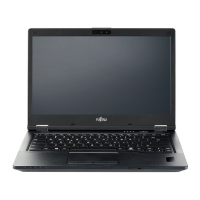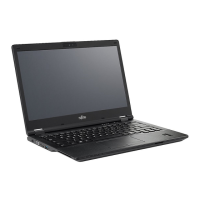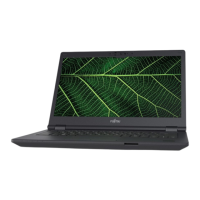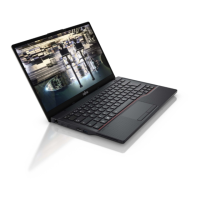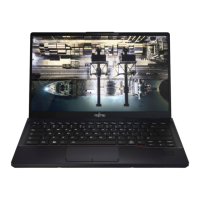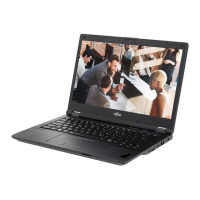Why does my Fujitsu LIFEBOOK E544 Laptop beep when battery is low?
- PPatrick JordanSep 10, 2025
If your Fujitsu Laptop beeps every few seconds, it means the battery is almost dead. You should charge the battery.
Why does my Fujitsu LIFEBOOK E544 Laptop beep when battery is low?
If your Fujitsu Laptop beeps every few seconds, it means the battery is almost dead. You should charge the battery.
How to resolve 'Operating system not found' error on Fujitsu LIFEBOOK E544?
If you receive the error message 'Operating system not found' on your Fujitsu Laptop, check in the BIOS Setup whether your hard disk has been set correctly and ensure that the operating system is installed on the corresponding drive.
What does 'Extended memory failed' mean on Fujitsu LIFEBOOK E544?
If you receive the error message 'Extended memory failed at offset: xxxx Failing Bits: zzzz zzzz' on your Fujitsu Laptop, check whether the additional memory module has been inserted correctly.
How to resolve 'Failure Fixed Disk n' error on Fujitsu Laptop?
If you receive the error message 'Failure Fixed Disk n' on your Fujitsu Laptop, start the BIOS Setup (Primary Master submenu) and select the correct settings for the hard disk drive.
Information on how to contact Fujitsu Service and Support for assistance.
Information on accessing the Fujitsu online store for purchasing products.
Guidance on using the Fujitsu Software Download Manager for driver updates.
Information regarding the limited warranty provided for the Fujitsu notebook.
Explanation of warning symbols and information icons used in the manual.
Defines conventions for text styles indicating actions, input, and output.
Lists components on the front like microphone, webcam, touchpad, indicators, and buttons.
Details ports on the left side including DC IN, LAN, Display Port, and USB.
Lists ports on the right side (headphones, USB) and rear (serial).
Describes components on the bottom like latches, battery compartment, and filter.
Essential safety information and warnings for notebook operation.
Safety for wireless components and advice on energy saving.
Guidelines for preparing and traveling with the notebook internationally.
Instructions for safely transporting and cleaning the notebook.
Steps to unpack, check for damage, and prepare the device for first use.
Guidance on choosing a suitable location and connecting the AC adapter.
Instructions for turning on the device and installing bonus applications.
Explains the meaning of various status LEDs on the notebook.
Detailed explanation of each status indicator's function and meaning.
Instructions for switching the notebook on and off correctly.
General keyboard information and key functions.
Details the function of specific keys like Backspace, Tab, Enter, Shift, Fn, etc.
Explains how to use virtual number keys on the keyboard.
Covers separate number keypads and basic Fn key combinations.
Lists further Fn key combinations for screen brightness, volume, and display output.
Details the ECO and Wireless application keys and keyboard settings.
Guide to using the touchpad for pointer movement, selection, and execution.
Details about LCD screen technology, pixels, and background lighting.
Information on using the integrated webcam for pictures, video, and chat.
Covers battery charging, maintenance, storage, and removal/installation.
Step-by-step instructions for safely removing the notebook battery.
Step-by-step instructions for safely installing the notebook battery.
Information about modular bay devices like hard drives and optical drives.
Procedures for removing and installing modular bay devices.
Information on optical drives and how to handle optical disks.
Instructions for inserting, removing, and emergency removal of optical disks.
Steps for removing and replacing the notebook's removable dust filter.
Guide to utilizing the notebook's energy saving features for extended battery life.
Information on the integrated memory card reader and its supported formats.
Details on speakers, microphones, and wireless LAN/Bluetooth components.
Instructions for connecting the notebook to a wired network.
Introduction to the port replicator and a diagram of its available ports.
Step-by-step guide for docking the notebook onto the port replicator.
Instructions for connecting the AC adapter to the replicator and powering on the notebook.
Steps for safely undocking the notebook from the port replicator.
Steps to set up and use the fingerprint sensor for system security.
Information on using the security lock and the initial setup of BIOS password protection.
Detailed instructions for assigning and changing supervisor and user passwords in BIOS.
Covers removing passwords, protecting OS boot, and hard disk passwords.
Steps for enabling and disabling the TPM security feature.
Information on using the Smart Card reader and inserting Smart Cards.
Important safety notes and general procedures for connecting external devices.
Instructions for connecting various types of external monitors (VGA, Display Port, DVI-D).
Connecting devices to the serial port and configuring port settings.
Guide to connecting various USB devices to the notebook's USB ports.
Details on using the special USB port for charging devices, even when the notebook is off.
Instructions for safely removing eSATA and USB storage devices.
How to connect external microphones, speakers, and headphones.
General precautions and safety notes for servicing the notebook components.
Steps to take before removing or changing any system components.
Procedures for installing and removing memory modules.
Step-by-step guide to removing the notebook's outer cover for access.
Detailed steps for removing a memory module from its slot.
Detailed steps for installing a memory module into its slot.
Steps for reattaching the notebook cover after servicing.
Steps for removing and installing the notebook's hard disk drive.
Final steps after component replacement, including reassembly and reconnecting cables.
How to access and navigate the BIOS Setup Utility menus.
Options for saving changes, discarding changes, or loading defaults in BIOS.
Steps to take when a fault occurs, including contacting support.
Information on how to restore the notebook's original factory image.
Troubleshooting for date/time, keyboard input, and LCD screen problems.
Solutions for issues with external monitors, such as blank screens or unstable images.
Troubleshooting for notebook not starting, stopping, or printer issues.
Resolving wireless connection, acoustic warnings, and Smart Card issues.
Explains common error messages generated by the BIOS Setup Utility.
Provides specifications for LIFEBOOK E544 and E554 regarding dimensions and memory.
Details on wireless LAN standards, frequencies, channels, and security.
Technical data for rechargeable batteries and the AC adapter.
Information on product disposal, battery recycling, and Canadian notices.
UL safety instructions, ENERGY STAR compliance, and FCC/IC regulatory information.
FCC interference and radio frequency exposure statements for wireless devices.
Information regarding export controls and specific usage restrictions for Canada.
Guide to setting up and configuring the optional wireless LAN device.
Describes WLAN device capabilities, supported standards, and Ad Hoc mode.
Explains Access Point (Infrastructure) mode for wireless networking.
General instructions for handling the WLAN device and its potential interferences.
How to deactivate WLAN, configure it in Windows, and connect to networks.
Common problems and solutions for wireless LAN connectivity issues.
Covers Bluetooth device usage, FCC/Canadian notices, warranty, and backup procedures intro.
Step-by-step guide for creating bootable disks and recovery image sets.
Backing up essential software and recovering the system when the hard drive is accessible.
Determining if recovery tools are pre-loaded and how to access them.
Details on the diagnostics tool and restoring the recovery image from a hidden partition.
Instructions for restoring the recovery image for a full hard drive.
Detailed steps for recovering the system image using recovery and utility tools.
Steps to install essential access software after the recovery image is restored.
Auto-installation support for software from backup locations and support websites.
Guide on using Fujitsu Software Download Manager (FSDM) to get the latest drivers.
| Form factor | Clamshell |
|---|---|
| Product type | Laptop |
| Product color | Black |
| Bus type | DMI |
| Stepping | C0 |
| Tjunction | 100 °C |
| Processor cache | 3 MB |
| Processor cores | 2 |
| Processor model | i3-4000M |
| System bus rate | 5 GT/s |
| Processor family | Intel® Core™ i3 |
| Processor series | Intel® Core™ i3-4000 Mobile Series |
| Processor socket | PGA946 |
| Processor threads | 4 |
| Processor codename | Haswell |
| Processor frequency | 2.4 GHz |
| Processor cache type | Smart Cache |
| Processor lithography | 22 nm |
| Processor manufacturer | Intel |
| Processor front side bus | - MHz |
| PCI Express slots version | 2.0 |
| Processor operating modes | 64-bit |
| ECC supported by processor | No |
| PCI Express configurations | 1x16, 2x8, 1x8+2x4 |
| Thermal Design Power (TDP) | 37 W |
| Maximum number of PCI Express lanes | 16 |
| Motherboard chipset | Intel® HM86 |
| Memory slots | 2x SO-DIMM |
| Internal memory | 4 GB |
| Memory clock speed | 1600 MHz |
| Memory form factor | SO-DIMM |
| Internal memory type | DDR3L-SDRAM |
| Maximum internal memory | 16 GB |
| HDD size | 2.5 \ |
| HDD interface | SATA |
| Storage media | HDD |
| Optical drive type | DVD Super Multi |
| Card reader integrated | Yes |
| Total storage capacity | 500 GB |
| Number of HDDs installed | 1 |
| Display surface | - |
| Display diagonal | 14 \ |
| Display resolution | - pixels |
| On-board graphics card ID | 0x416 |
| Discrete graphics card model | Not available |
| On-board graphics card model | Intel® HD Graphics 4600 |
| On-board graphics card family | Intel® HD Graphics |
| Maximum on-board graphics card memory | 2 GB |
| On-board graphics card base frequency | 400 MHz |
| On-board graphics card DirectX version | 11.1 |
| On-board graphics card dynamic frequency (max) | 1100 MHz |
| Wi-Fi standards | 802.11b, 802.11g, Wi-Fi 4 (802.11n) |
| Bluetooth version | 4.0 |
| Ethernet LAN data rates | 10, 100, 1000 Mbit/s |
| Charging port type | DC-in jack |
| USB 2.0 ports quantity | 0 |
| USB 3.2 Gen 1 (3.1 Gen 1) Type-A ports quantity | 3 |
| Pointing device | Touchpad |
| Recovery operating system | Windows 7 Professional |
| Operating system installed | Windows 8.1 Pro |
| Processor code | SR1HC |
| Processor ARK ID | 75104 |
| Intel TSX-NI version | 0.00 |
| Processor package size | 37.5 x 37.5 x 4.7 mm |
| Supported instruction sets | AVX 2.0, SSE4.1, SSE4.2 |
| Intel Identity Protection Technology version | 1.00 |
| Battery capacity | 63 Wh |
| Battery life (max) | 11.3 h |
| Number of battery cells | 6 |
| AC adapter power | 65 W |
| AC adapter frequency | 50 - 60 Hz |
| AC adapter input voltage | 100 - 240 V |
| AC adapter output current | 3.42 A |
| AC adapter output voltage | 19 V |
| Cable lock slot type | Kensington |
| Operating temperature (T-T) | 5 - 35 °C |
| Operating relative humidity (H-H) | 20 - 80 % |
| Sustainability certificates | RoHS, ENERGY STAR |
| Depth | 231 mm |
|---|---|
| Width | 338 mm |
| Weight | 1900 g |
| Height (rear) | 31.4 mm |
| Height (front) | 25.1 mm |
